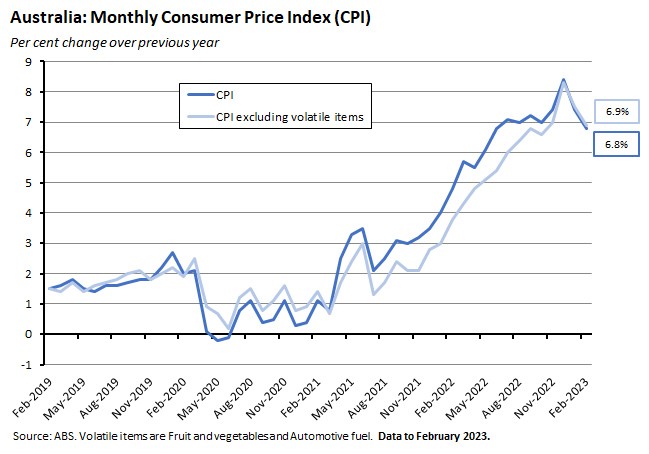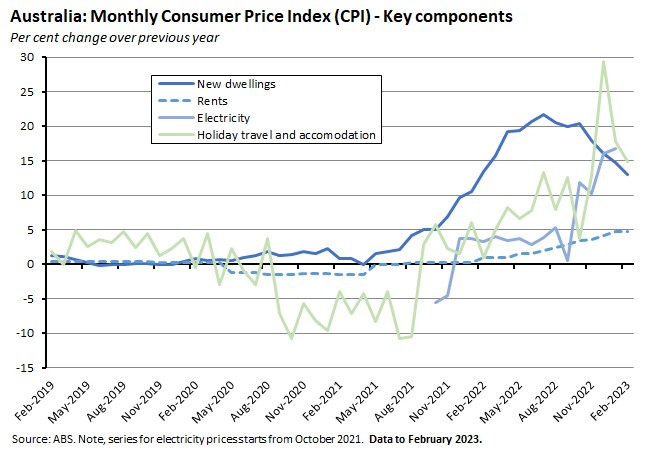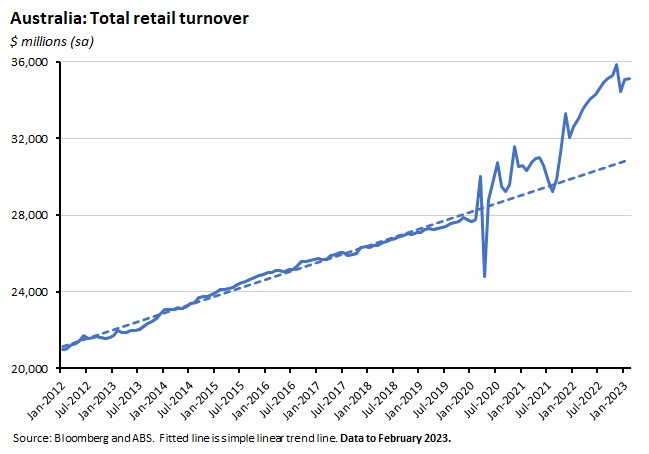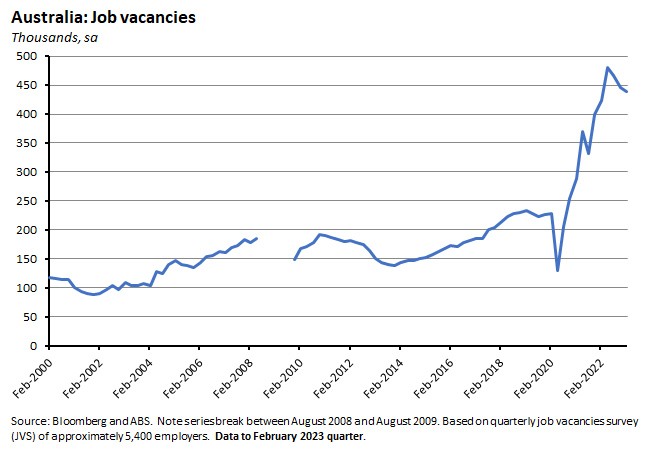This week’s focus was on the ABS monthly consumer price index (CPI) indicator and retail sales numbers for February 2023. Readers will recall that the RBA had flagged these two items, along with earlier releases on employment and the NAB business survey, as key inputs for judging the case for a break in the tightening cycle at next week’s monetary policy meeting. Our earlier assessment was that employment and business survey results alone were insufficient to make the case for a pause. In contrast, this week’s results are more compelling. In particular, the monthly indicator shows that price pressures continued to ease last month, adding more evidence to support the RBA’s call that inflation peaked in the final quarter of 2022.
In addition, the retail trade data were broadly consistent with the proposition that the period of rapid catch-up growth in consumer spending post-lockdown has run its course. Add those results to the financial disruption that has roiled global markets in recent weeks, plus the point that the RBA was already contemplating the case for a break even before the chain reaction kicked off by the failure of Silicon Valley Bank, and there is now a decent case to be mounted for Martin Place leaving the cash rate unchanged next Tuesday. Indeed, at the time of writing, that was what market pricing was predicting. Moreover, according to the ASX cash futures implied yield curve, markets are currently expecting not just a pause, but no more rate hikes at all.
Granted, just because it is now possible to build a credible case for a pause, it does not necessarily follow that the RBA will choose to hold fire next week. To make the case against pausing, consider that inflation continues to be far above target, the labour market remains tight and cost pressures are still significant. And while the RBA has used its recent communications to signal that it understands the case for postponing a rate hike, those same communications indicate Martin Place ‘expects that further tightening of monetary policy will be needed to ensure that inflation returns to target’. Moreover, three of the RBA’s most important peers (the Fed, the ECB and the Bank of England) – whose economies are more exposed to the current banking turmoil than Australia’s – have all recently demonstrated that in their judgment the recent tightening of financial conditions was insufficient to merit a pause in their own tightening cycles. So, even if the RBA did decide to put rate increases on hold next week, it will nevertheless likely maintain a tightening bias and could look to hike in May instead. In which case, one might ask, why pause?
Still, on balance, our best guess is that the RBA will choose to hold the cash rate target unchanged on 4 April and use the flexibility afforded by its regular monthly schedule of meetings to ‘assess more fully the effect of the interest rate increases to date…recognising that pausing would allow additional time to reassess the outlook for the economy’. But we think this is an extremely close call.
On the The Dismal Science podcast this week, we consider the case for and against the RBA raising interest rates again next week.
The annual inflation rate as measured by the monthly CPI fell to 6.8 per cent last month
The ABS Monthly Consumer Price Index Indicator rose 6.8 per cent over the year to February 2023, down from 7.4 per cent in January, marking a second successive monthly fall from December’s peak 8.4 per cent reading. February’s outcome was also below the consensus forecast, which had expected a 7.2 per cent print.

The CPI excluding volatile items (fruit and vegetables and automotive fuel) rose by 6.9 per cent in annual terms. Again, that was down from January’s 7.5 per cent result.
According to the Bureau, the key drivers of February’s inflation result were housing (up 9.9 per cent over February 2022), food and non-alcoholic beverages (up eight per cent), transport (up 5.6 per cent) and recreation and culture (up 6.4 per cent).
Notably, the rate of increase of several key components across these categories – while still strong – slowed last month. For example, the 13 per cent rise in new dwellings was the lowest rate of annual growth seen since February 2022. The 5.6 per cent increase in automotive fuel prices was the lowest in two years and the rate of increase in prices for holiday travel and accommodation has now eased from 29.3 per cent in December 2022 to 17.8 per cent in January 2023 and to 14.9 per cent in February. The price of fruit and vegetables also experienced their largest quarterly fall since 2012, although prices were still up 8.5 per cent over the year.

At the same time, the annual rate of increase in electricity prices (up 17.2 per cent) and rents (up 4.8 per cent) both remained elevated last month, and tight conditions in the rental market suggest continued upward pressure from the latter.
Finally, it is worth recalling that the monthly indicator comes with several limitations and as such is very much subordinate to the quarterly CPI which remains the principal measure of CPI inflation. The methodology of the monthly indicator means that not all prices are adjusted each month (only about 43 per cent of the CPI basket by weight is collected on a monthly basis) while those prices that are measured on a quarterly basis (about 47 per cent) are recorded in the month they are measured: for example, consumer durables tend to be priced in the first month of each quarter, market services in the second, and many administered prices in the third. These differences in the coverage of prices mean the indicator is volatile month-to-month and the ABS recommends using either year-ended or three-month-ended growth rates. Unlike the quarterly index, the monthly indicator is subject to revisions. And it is still very much a work in progress. For example, the February release brought the inclusion of a monthly electricity price index for the first time, while the December 2022 monthly indicator release saw the ABS announce it was suspending publication of its monthly trimmed mean series as the latter was failing to provide a reliable indicator for the quarterly measure of trimmed mean inflation.
Retail sales look to have levelled out
The ABS said retail sales rose 0.2 per cent over the month in February 2023 (seasonally adjusted) to be 6.4 per cent above their level in February 2022. The Bureau said retail sales ‘appear to have levelled out after a period of increased volatility’ over the November-January period, and on average, spending has been flat through the close of last year and in to 2023.

While spending on food-related industries continued to grow solidly last month, there were signs elsewhere that consumers were scaling back discretionary spending in response to higher cost of living pressures. Card data on spending reported by the ANZ and CBA banks suggest spending has weakened further over this month. That in turn suggests that the rapid period of ‘catch-up’ spending after the pandemic may have finished. Note that in dollar terms, turnover remains well above its pre-pandemic trend, albeit now inflated by higher prices.
What else happened on the Australian data front this week?
ABS data on job vacancies show the total number of vacancies fell to 438,500 in February 2023, down 1.5 per cent or about 6,600 vacancies from November 2022. The ABS noted that while this was the third consecutive quarter of declining job vacancies, the number of openings remained high, at nearly double (92 per cent higher than) their pre-pandemic level of around 227,900 in February 2020. The share of businesses reporting at least one vacancy also fell for the first time in six quarters, easing to 24.3 per cent from 27.7 per cent in November. That was still more than double the 11 per cent share prevailing pre-pandemic in February 2020.

The weekly ANZ-Roy Morgan Consumer Confidence Index was virtually unchanged last week, with a reading of 76.6 (up from 75.5 the previous week). The index has now been below 80 for four consecutive weeks, indicating a prolonged period of weakness. The measure of ‘weekly inflation expectations’ fell by half a percentage point to 5.4 per cent.
Other things to note . . .
- The RBA’s Head of Payment Policy gave a speech on policy issues raised by the shift to electronic payments. Over the past three years, the share of consumer transactions made using cash has halved to just 13 per cent. Cards are now the dominant retail payment method (with a share of 75 per cent) and the use of mobile devices for card payments has grown rapidly over recent years.
- Grattan’s Tony Wood on the government’s modified safeguard mechanism.
- Peter Martin asks how economists would raise $20 billion a year to fund government priorities.
- This e61 research note analyses the relationship between immigration and firm productivity in Australia and finds migrant workers are more likely to work in lower productivity industries than non-migrant workers, and are more likely to work at lower productivity firms within industries. This is mostly the case for ‘untargeted’ visas (student and working holiday makers) with migrant workers on more ‘targeted’ visas (permanent and temporary skilled) more likely to work in higher productivity firms than non-migrant workers.
- Jenny Gordon on the economics of AUKUS.
- On the eve of the Treasurer receiving the recommendations of the Review into the RBA, former governor Bernie Fraser reckons the central bank has done a decent job overall. Importantly, they were asked to choose measures based on the efficiency of the tax and not to consider political constraints. Land and resource taxes top the list.
- The SMH predicts what the RBA review will recommend: A specialist monetary policy committee, fewer board meetings and more press conferences. But no changes to the inflation targeting framework.
- A new report from the World Bank on falling long-term growth prospects says the world economy is in the midst of a structural growth slowdown, with global potential growth set to fall to a three-decade low over the remainder of this decade. Investment and productivity rates have both fallen, the global labour force is ageing and international trade growth has weakened.
- On the other hand, see also Generative AI, economic growth and productivity.
- Danielsson and Goodhart on What Silicon Valley Bank and Credit Suisse tell us about financial regulations. Their argument is that financial authorities have been caught in an impossible ‘financial trilemma’ - seeking to maintain growth while keeping inflation under control and financial stability high. In the decade following the GFC, it seemed possible to hit all three targets, but the longer monetary policy stayed loose, the more systemic risk increased, undermining financial stability. The regulatory response should have been to increase capital, but this would have been recessionary, conflicting with the target of sustaining growth. They propose some radical solutions – for example, requiring senior bank management to face multiple liabilities and CEOs unlimited liability. That would seem to have very little prospect of being adopted.
- Related, Charles Calomiris on bank reform.
- The WSJ’s Greg Ip thinks the US could face a slow-motion banking crisis.
- And in the FT, Martin Wolf argues it’s wrong to (only) blame loose monetary policy for the world’s banking problems.
- Helpful IMF guide to international committees, groups and clubs, from the International Monetary and Financial Committee (IMFC) to the Financial Stability Board (FSB), via the G’s-7 to -77.
- Two useful summary VoxEU columns pulling together recent IMF work on geo-economic fragmentation.
- Wired magazine goes inside TSMC.
- Why do so many things (cars, coffee shops, cities, brands) look the same? Welcome to the Age of Average.
- Grattan podcast on Australia’s productivity predicament.
- Tyler Cowen in conversation with Jonathan GPT Swift. Not a particularly riveting conversation…until, that is, you recall what’s actually happening here.
Latest news
Already a member?
Login to view this content


